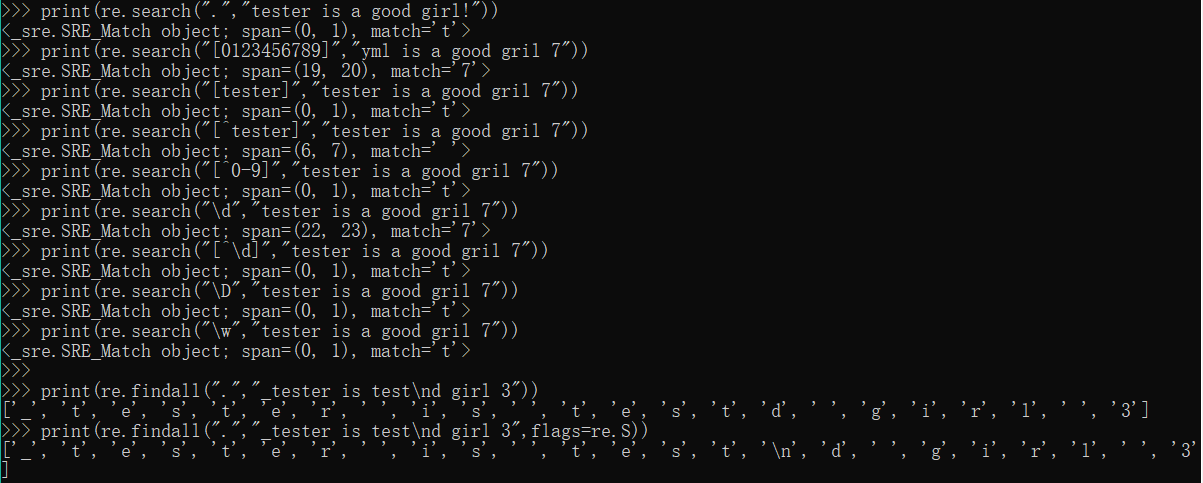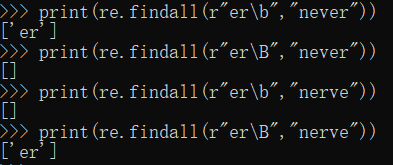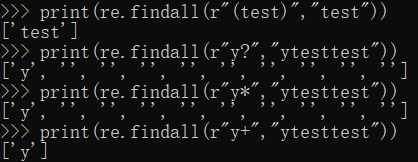python3笔记二十三:正则表达式之元字符
一:学习内容
- 匹配单个字符与数字:.、[]、^、\d、\D、\w、\W、\s、\S
- 匹配锚字符(边界字符):^、$、\A、\Z、\b、\B
- 匹配多个字符:(xyz) 、x?、x*、.*、x+、x{n}、x{n,}、x{n,m}、x|y
- 非贪婪匹配:*?、+?、??、{n,m}?
二:匹配单个字符与数字
1.点.:匹配除换行符以外的任意字符
2.[]:是字符集合,表示匹配方括号中所包含的任意一个字符
[0123456789] 表示匹配任意一个数字
[0-9] 表示匹配任意一个数字
[yml] 表示匹配'y','m','l'中任意一个字符
[a-z] 表示匹配任意一个小写字符
[A-Z] 表示匹配任意一个大写字符
[0-9a-zA-Z] 表示匹配任意一个数字和字母
[0-9a-zA-Z_] 表示匹配任意一个数字、字母和下划线
3.^:是脱字符,表示不匹配集合中的字符,注意^在[]中才表示不匹配,在其他位置意义不一样
[^test] 表示匹配除了test这几个字母以外的所有字符
[^0-9] 表示匹配所有的非数字字符
4.\d:匹配数字,效果同[0-9]
\d 表示匹配任意一个数字,这里可以不写[],直接使用\d
[^\d] 表示匹配所有的非数字字符,效果同[^0-9]
5.\D:匹配非数字字符,效果同[^0-9]
6.\w:匹配数字、字母和下划线,效果同[0-9a-zA-Z]
7.\W:匹配非数字、字母和下划线,效果同[^0-9a-zA-Z]
8.\s:匹配任意的空白符(空格、换行、回车、换页、制表符),效果同[ \f\n\r\t]
9.\S:匹配任意的非空白符(空格、换行、回车、换页、制表符),效果同[^ \f\n\r\t]
10.举例:
print(re.search(".","tester is a good girl!")) #.可以代表任意字符,所以匹配t,结果匹配一个t
print(re.search("[0123456789]","yml is a good gril 7")) #匹配结果为数字7
print(re.search("[tester]","tester is a good gril 7")) #匹配结果为一个t
print(re.search("[^tester]","tester is a good gril 7")) #匹配除tester之外的任意一个字符结果为空" "
print(re.search("[^0-9]","tester is a good gril 7")) #匹配一个非数字字符结果为t
print(re.search("\d","tester is a good gril 7")) #匹配结果为数字7
print(re.search("[^\d]","tester is a good gril 7")) #匹配结果为一个t
print(re.search("\D","tester is a good gril 7")) #匹配一个非数字字符结果为t
print(re.search("\w","tester is a good gril 7")) #匹配任意一个数字字母或下划线,结果为t
print(re.findall(".","_tester is test\nd girl 3")) #匹配除换行符以外的任意字符
print(re.findall(".","_tester is test\nd girl 3",flags=re.S)) #匹配包括换行符在内的任意字符

三:匹配锚字符(边界字符)
1.^:行首匹配,注意^在[]中才表示不匹配集合中的字符
2.$:行尾匹配
3.\A:匹配字符串开始,它和^区别是:
\A只匹配整个字符串的开头即使在re.M模式下,也不会匹配其他行的行首
^匹配的是每行的行首
4.\Z:匹配字符串结束,它和$区别是:
\Z只匹配整个字符串的结束即使在re.M模式下,也不会匹配其他行的行尾
$匹配的是每行的行尾
5.\b:匹配一个单词的边界,也就是指单词和空格间的位置
6.\B:匹配非单词的边界,也就是指单词和空格间的位置
7.举例:
print(re.search("^test","test is a good girl")) #表示行首必须要是test开头
print(re.search("girl$","test is a good girl")) #表示行尾必须要是girl结尾
print(re.search("\Atest","test is a good girl"))
print(re.findall("^test","test is a good girl\ntest is a good girl",flags=re.M))
print(re.findall("\Atest","test is a good girl\ntest is a good girl",flags=re.M))
print(re.findall("girl$","test is a good girl\ntest is a good girl",flags=re.M))
print(re.findall("girl\Z","test is a good girl\ntest is a good girl",flags=re.M))
print(re.findall(r"er\b","never"))
print(re.findall(r"er\B","never"))
print(re.findall(r"er\b","nerve"))
print(re.findall(r"er\B","nerve"))

四:匹配多个字符
说明:下方的x、y、z均为假设的普通字符,n、m为非负整数,不是正则表达式的元字符
1.(xyz):匹配小括号内的内容,()内的内容xyz作为一个整体去匹配
2.x?:匹配0个或者1个x,非贪婪匹配(尽可能少的匹配)
3.x*:匹配0个或者任意多个x,贪婪匹配(尽可能多的匹配)
.*:表示匹配0个或任意多个字符(换行符除外)
4.x+:匹配至少一个x,贪婪匹配(尽可能多的匹配)
5.x{n}:匹配确定的n个x,n是一个非负整数
6.x{n,}:匹配至少n个x,n是一个非负整数
7.x{n,m}:匹配至少n个最多m个x,注意:n <= m
8.x|y:|表示或,匹配的是x或y
9.举例:
print(re.findall(r"(test)","test"))
print(re.findall(r"y?","ytesttest")) #匹配0个或1个
print(re.findall(r"y*","ytesttest")) #匹配0个或任意多个,贪婪匹配
print(re.findall(r"y+","ytesttest")) #匹配至少1个,贪婪匹配

print(re.findall(r"y{3}","ytestyyytest")) #匹配3个y
print(re.findall(r"y{3,}","yytestyyytest")) #匹配至少3个y
print(re.findall(r"y{3,6}","yytestyyytest")) #匹配至少3个y,最多6个y

print(re.findall(r"(t|T)est","tttestttttest")) #匹配t或T
print(re.findall(r"t|Test","tttestttttest"))
print(re.findall(r"((t|T)est)","tttestttttest"))

#需求:提取tester......girl
str = "tester is a good girl!tester is a nice girl!tester is a very dddd girl"
print(re.findall(r"tester.*girl",str))
print(re.findall(r"tester.*?girl",str)) #非贪婪

五:非贪婪匹配
1. *?:前一个字符0次或无限次扩展,最小匹配
print(re.findall(r"tes*","tessssssssssssss"))
print(re.findall(r"tes*?","tessssssssssssss"))
print(re.findall(r"tess*","tessssssssssssss"))
print(re.findall(r"tess*?","tessssssssssssss"))

2. +?:前一个字符1次或无限次扩展,最小匹配
print(re.findall(r"tes+","tessssssssssssss"))
print(re.findall(r"tes+?","tessssssssssssss"))
print(re.findall(r"tess+","tessssssssssssss"))
print(re.findall(r"tess+?","tessssssssssssss"))

3. ??:前一个字符0次或1次扩展,最小匹配
print(re.findall(r"tes?","tessssssssssssss"))
print(re.findall(r"tes??","tessssssssssssss"))
print(re.findall(r"tess?","tessssssssssssss"))
print(re.findall(r"tess??","tessssssssssssss"))

4. {n,m}?:扩展前一个字符n到m次,含m,最小匹配
print(re.findall(r"tes{1,2}","tessssssssssssss"))
print(re.findall(r"tesss{1,2}","tessssssssssssss"))
print(re.findall(r"tes{1,2}?","tessssssssssssss"))
print(re.findall(r"tesss{1,2}?","tessssssssssssss"))

python3笔记二十三:正则表达式之元字符的更多相关文章
- python3笔记二十三:正则表达式之其他函数
一:学习内容 re.split函数 re.finditer函数 re.sub函数 group()分组 re.compile函数 二:字符串切割---re.split函数 需要导入包:import re ...
- python3.4学习笔记(二十三) Python调用淘宝IP库获取IP归属地返回省市运营商实例代码
python3.4学习笔记(二十三) Python调用淘宝IP库获取IP归属地返回省市运营商实例代码 淘宝IP地址库 http://ip.taobao.com/目前提供的服务包括:1. 根据用户提供的 ...
- (C/C++学习笔记) 二十三. 运行时类型识别
二十三. 运行时类型识别 ● 定义 运行时类型识别(Run-time Type Identification, RTTI) 通过RTTI, 程序能够使用基类的指针或引用来检查(check)这些指针或引 ...
- python3笔记二十二:正则表达式之函数
一:学习内容 re.match函数 re.search函数 re.findall函数 二:re.match函数 需要导入包:import re 1.格式:match(pattern,string,fl ...
- 【Python3 爬虫】08_正则表达式(元字符与语法)
元字符表 符号 说明 示例 . 表示任意字符 'abc' >>>'a.c' >>>结果为:'abc' ^ 表示字符开头 'abc' >>> ...
- Java基础学习笔记二十三 Java核心语法之反射
类加载器 类的加载 当程序要使用某个类时,如果该类还未被加载到内存中,则系统会通过加载,链接,初始化三步来实现对这个类进行初始化. 加载就是指将class文件读入内存,并为之创建一个Class对象.任 ...
- angular学习笔记(二十三)-$http(1)-api
之前说到的$http.get和$http.post,都是基于$http的快捷方式.下面来说说完整的$http: $http(config) $http接受一个json格式的参数config: conf ...
- python3笔记二十四:Mysql数据库操作命令
一:学习内容 Mysql操作命令:启动服务.停止服务.连接数据库.退出数据库.查看版本.显示当前时间.远程连接 数据库操作命令:创建数据库.删除数据库.切换数据库.查看当前选择的数据库 表操作命令:查 ...
- python3笔记二十一:时间操作datetime和calendar
一:学习内容 datetime calendar 二:datetime 1.模块说明:可以理解为datetime基于time进行了封装,提供了各种使用的函数,datetime模块的接口更直接,更容易调 ...
随机推荐
- MyBatis-plus 新增实例,主键ID从很大的数字开始
mybatis-plus是mybatis增强版,用mybatis-plus可以省去很多DAO层代码和数据库操作语句的编写.但是需要我们配置好条件. 情景: 向数据库新增一条实例,我们要调用 inser ...
- npm安装淘宝镜像cnpm
在cmd中执行 npm install -g cnpm --registry=https://registry.npm.taobao.org
- vue打开到新页面,并传递参数
打开新页面,有两种方式, 一种是标签式: <router-link tag="a" target="_blank" :to="{path: '/ ...
- HTML的学习2(代码)
<!DOCTYPE html> <html> <head> <meta charset="UTF-8"> <title> ...
- 退居三线iOS开发的自主开发历程
忙前忙后,一切终将步入正轨,在忙也要抽出时间思考自己的事情 推荐一篇简书(https://www.jianshu.com/u/8367278ff6cf)讲解很官方 Metal体验 学习了一些基础的视频 ...
- payload免杀之Installutil.exe&csc.exe利用
0x00 前言 C#的在Windows平台下的编译器名称是Csc.exe.Installutil.exe工具是一个命令行实用程序,允许您通过执行指定程序集中的安装程序组件来安装和卸载服务器资源,可以执 ...
- qt tableview中如何添加右键菜单且不可编辑单元格
QTableView是一个比较实用的类,下面教给大家如何在QTableView中添加右键菜单. #include <QMenu>#include <QAction> QTabl ...
- 如果在docker中部署tomcat,并且部署java应用程序
1.先说如何在docker中部署tomcat 第一步:root用户登录在系统根目录下创建文件夹tomcat7,命令如:mkdir tomcat7,并且切换到该目录下:cd tomcat7: 第二步:创 ...
- hive--构建于hadoop之上、让你像写SQL一样编写MapReduce程序
hive介绍 什么是hive? hive:由Facebook开源用于解决海量结构化日志的数据统计 hive是基于hadoop的一个数据仓库工具,可以将结构化的数据映射为数据库的一张表,并提供类SQL查 ...
- Java面向对象(一)
面向对象(Object Oriented) 面向过程:事物比较简单.将问题分解为若干个步骤.按照步骤依次执行.面向对象:事物比较复杂.在解决面向对象的过程中,最后的执行部分还是面向过程方式,面向过程和 ...
